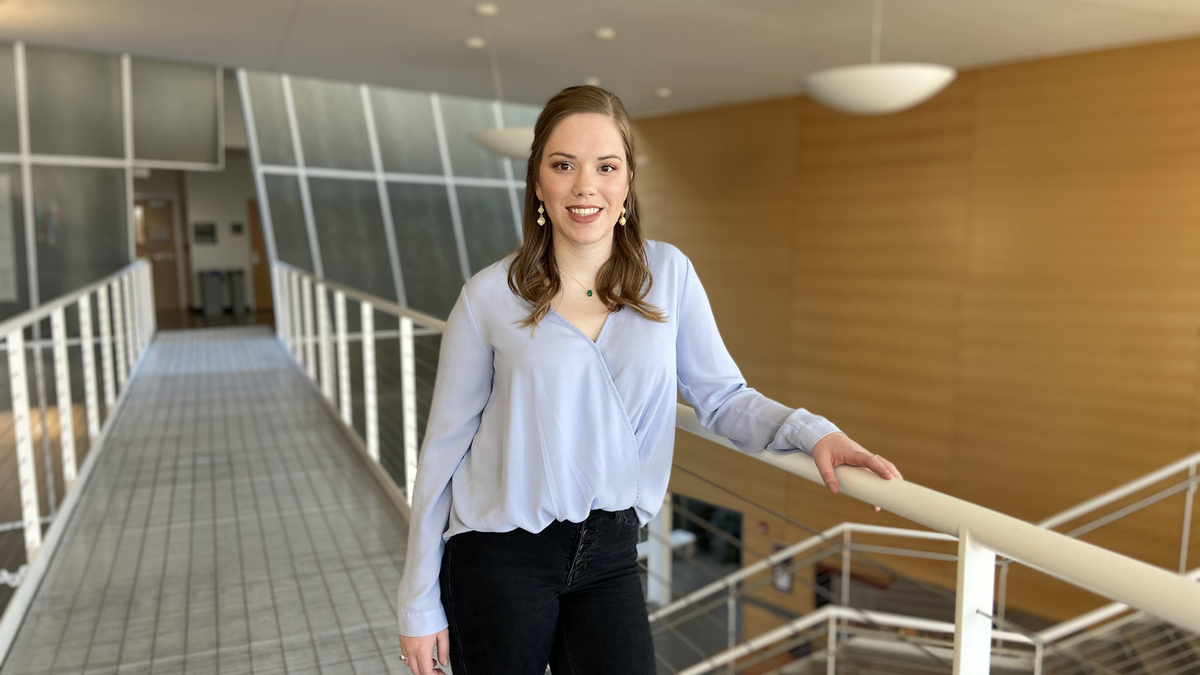Kari Olson can handle many different responsibilities at once. She credits that to one of her personality traits, “I’m really stubborn,” she laughs. She recalls an argument she had with her parents. “I don’t even remember what I was being difficult about, but I am sure I was in the wrong... We were about 10 miles away from home and my parents pulled over and told me to ‘shape up or walk.’ So I got out of the pick-up truck and started walking.” She knew the shortcuts and snowmobile trails and made it home. “If you throw down the gauntlet, I’ll take it,” she says.
Perseverance and Persistence
The tenacity Olson showed in high school has served her well in college. She’s finishing her biochemistry degree in spring 2021 with a teaching assistant job and an undergraduate research project in hand.
She is the lead teaching assistant for a biochemistry lab section. “I have felt a big responsibility to deliver to my students. They're coming to the lab, in-person, during COVID to learn biochemistry skills. They’re showing up in such a big way: during a pandemic.”
Olson remarks on the pressure of being in a role usually filled by graduate students. “I have found I learn a tremendous amount through teaching,” she says. The opportunity to work closely with so many students conducting intricate science experiments has pushed her. “Each experience gives me something I didn’t have [before],” she says.
Learning from Protein
In addition to a heavy schedule, Olson is a part of Dr. Anne Hinderliter’s research lab on campus. The group of undergraduate and graduate students is examining the qualities of a particular protein named dystrophin, which has a role in muscular dystrophy.
Their process was elaborate. They grew E. coli to make the human dystrophin protein. Next, they purified the dystrophin by destroying the E. coli. Lastly, they melted the dystrophin to see how it breaks down.
For the past year, the lab has been growing and examining this protein, which wasn’t a fast process. The lab also used a new piece of equipment: a circular dichrometer. “We spent months trying to figure out how this fancy, expensive machine worked [and] purifying a protein sample.”
The experiment culminated on one day. They ran samples from early morning into the night. “We got a whole bunch of data that helped us better understand the structure [of the protein], and it was really interesting,” she says. The sample they ran did not look like other samples. “It told us something!”
Olson recalled how those months paid off, “There’s a lot that goes into science that isn’t always flashy,” she says. That day, the research added information to the body of knowledge. “Those are the solid wins that research is built on.”
Olson and her lab mates aren’t just purifying proteins for the fun of it. This year, Olson has presented the lab's work at two conferences, the Annual Biophysical Society Meeting and the Gibbs Thermodynamic Conference. “To present at a conference, you need to have done your own research, interpret your results, and tell people why what you're doing matters.”
Science, Technology, Engineering, and Math: STEM
At the end of Olson’s senior year at UMD, she says she wouldn’t do much differently. “I would tell myself to... listen to my internal voice.” Olson grew up in Ettrick, Wisconsin. “It is so easy to get caught up in the societal messaging of what a woman can or cannot do," she says. "Coming from a small town, I hadn’t seen a lot of women with graduate degrees in science. It's so easy to fall into the pattern of wondering, ‘why me?’ but that internal voice says, ‘why not?’ ”
She says she's had great mentors. "The role modeling from talented women faculty members within Swenson College has been huge for me. My mentor, Dr. Hinderliter, and other faculty like Dr. Tracy Bibelnieks and Dr. Jessica Sieber, all have shown me what it means to be a successful woman in STEM.”
Olson has a two-part goal. Immediately after graduation she plans to work as an Emergency Medical Technician. After that, she’s looking forward to medical school and biomedical research.
About the Chemistry and Biochemistry Department
___
This story was co-written by UMD student Jack Harrington, who is majoring in writing studies and minoring in sociology and LGBT studies. Jack works with Cheryl Reitan in University Marketing and Public Relations.
